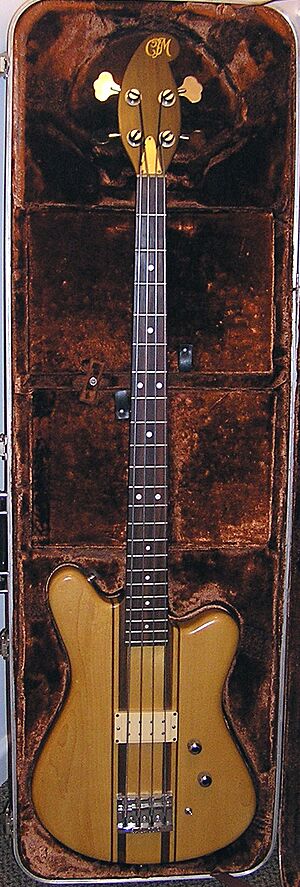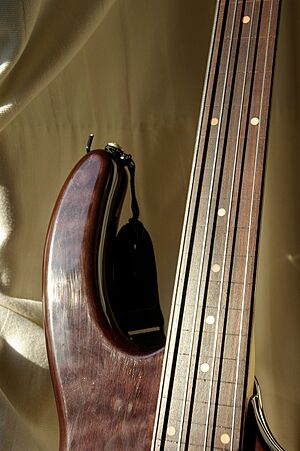Bass guitar facts for kids
A bass guitar (also called an electric bass or bass) is a string instrument that is like an electric guitar. It looks similar to an electric guitar but is longer. The electric bass has many of the same parts as an electric guitar. However, the bass guitar makes much lower sounds.
Bass guitars are used to play low musical sounds. These low sounds are called "bass lines." You can hear bass lines in many types of music. This includes rock, pop, country, jazz fusion, and many more.
Contents
How the Bass Guitar Was Invented
The first bass guitar was made in the 1930s. An inventor named Paul Tutmarc created it in Seattle, Washington. But not many musicians were interested in his instrument back then.
In the 1950s, musicians needed a new instrument. At that time, the double bass was the main low-sounding instrument. It was used in jazz, blues, folk, early rock music, and bluegrass. The double bass had some problems:
- It was very big and heavy.
- It was hard to carry around.
- It was difficult to play notes exactly right.
- It was hard to make it louder with a bass amplifier.
Musicians wanted a smaller, lighter instrument. They also wanted one that was easier to play and make louder. Many inventors tried to build a better bass instrument. One important inventor was Leo Fender in the United States. Leo Fender used Tutmarc's ideas and made his own bass guitar in the 1950s.
Leo Fender used many parts similar to those on an electric guitar for his bass. He called his instrument the "Fender Precision Bass." He used the word "Precision" because his bass had metal frets on the neck. The double bass did not have frets. The frets on Fender's bass made it easier for musicians to play notes precisely. Leo Fender's bass guitar became very popular. Even today, many bass guitars are designed to look like his Fender Precision Bass.
What a Bass Guitar Looks Like
Most bass guitars are made from wood. The main parts are the body, neck, fingerboard, frets, and strings.
- The body is the largest part, made of wood.
- A wooden neck is attached to the body.
- A wooden fingerboard is glued onto the neck.
- Thin metal strips called frets are glued onto the fingerboard. These frets help players find the right notes.
At the bottom of the body is the bridge. This is a metal part where one end of the strings is attached. On some basses, the strings go through the back of the body into the bridge. On others, they fit into the front of the bridge. Some basses have a special area inside the body for electrical parts. These are often called "active basses." The bridge usually has ways to change how high the strings sit.
The body also has pickups and knobs or switches.
- Pickups are magnetic devices under the strings. When the strings vibrate, pickups create an electrical signal. This signal goes through a cable to an amplifier.
- Pickups can be "passive" (sending the signal as is) or "active" (processing the signal first).
- Some basses have two pickups, often called "bridge" and "neck" pickups. A switch lets the player choose which pickup to use, or mix them. Each pickup can make a slightly different sound.
- The knobs control things like the volume (how loud the sound is) and tone (how bright or deep the sound is).
At the other end of the neck is the headstock. This part holds the tuners, which let players adjust the strings' pitch. Where the strings leave the fingerboard and go to the tuners, there is a nut. This is a piece of metal or plastic with grooves to hold the strings in place.
Inside most necks is a long metal rod called a truss rod. This rod helps adjust the tension on the neck. The neck is slightly curved, which helps the strings vibrate freely without buzzing.
The scale of an electric bass is the length of the strings from the nut to the bridge. It is usually 34 inches (84 centimeters). However, shorter and longer basses are also made. Longer basses are sometimes preferred in styles like heavy metal. This is because the strings are tuned lower, and longer scales help keep the strings tighter.
Most standard bass guitars have four metal strings. But you can also find basses with five, six, or even eight strings. The strings themselves are made in different ways and from different materials. This changes how they sound.
In the 1960s and 1970s, some musicians removed the frets from their bass guitars. A bass guitar without frets is called a fretless bass guitar. This changes the sound, especially when the player slides their fingers along the strings. For example, Pino Palladino played a fretless bass in the 1980s. He played for famous musicians like Eric Clapton and David Gilmour. Fretless basses are often used in jazz and jazz fusion. However, bassists in other genres, like metal bassist Steve DiGiorgio, also use them.
How Bass Guitars Make Sound
The most common bass guitar has four strings. They are usually tuned to E, A, D, and G, from the lowest sound to the highest. Players sometimes tune the strings even lower, especially in styles like heavy metal that like deep sounds. Five-string basses add a lower string, usually tuned to B. Six-string basses add a higher string, usually tuned to C. In standard tuning, each string is tuned a "perfect fourth" higher than the string below it.
Musicians make sounds from the strings in several ways:
- Fingerstyle: This is the most common way. The player plucks the strings upwards with their fingertips, usually the index and middle fingers.
- Slap-and-pop: The player hits the lower strings hard with their thumb ("slap"). They then pull the higher strings upwards and let them snap against the fingerboard ("pop"). This creates a bright, percussive sound.
- Tapping: The player presses their fingertips down onto the frets on the fingerboard. This makes a sound without plucking or picking.
- Picks: Players can also use small pieces of metal or plastic called "picks." Using a pick often creates a sharper sound than using fingers.
Some bass guitars have a tremolo on the bridge. This lets the player change the pitch of the strings while playing.
Where the strings are plucked also changes the sound. Plucking closer to the bridge generally makes a more muted sound. Plucking closer to the neck makes a fuller, more resonant sound.
When a musician plucks the strings, they vibrate. The magnetic pickups under the strings detect these vibrations. The vibrations are then changed into an electronic signal. This signal travels through a metal cable to an electronic amplifier and a loudspeaker. The musician can turn a volume knob on the bass to make the sound louder or softer.
Images for kids
-
An early Fender Precision Bass
See also
 In Spanish: Bajo eléctrico para niños
In Spanish: Bajo eléctrico para niños






